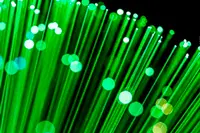 A new way to process fibre optic signals has been demonstrated by UCL researchers, who claim the approach could double the distance over which data travels error-free through submarine cables. Because the new method does not require signals to be boosted, it has the potential to reduce the costs of long-distance optical fibre communications.
A new way to process fibre optic signals has been demonstrated by UCL researchers, who claim the approach could double the distance over which data travels error-free through submarine cables. Because the new method does not require signals to be boosted, it has the potential to reduce the costs of long-distance optical fibre communications.
The work, sponsored by EPSRC, addresses a new way of improving the transmission distance by undoing interactions between different optical channels as they travel over an optical cable.
Study author Dr Robert Maher said: "By eliminating the interactions between optical channels, we can double the distance signals can be transmitted error free from 3190km to 5890km – the largest increase ever reported for this system architecture.
"The challenge is to devise a technique to simultaneously capture a group of optical channels, known as a 'super channel', with a single receiver. This allows us to undo the distortion by sending the data channels back on a virtual digital journey at the same time."
The researchers used a '16QAM super channel', comprised of a set of frequencies which could be coded using amplitude, phase and frequency to create a high capacity optical signal. The super channel was then detected using a high speed super receiver and new signal processing techniques developed by the team enabled the reception of all the channels together and without error.
The researchers now plan to test the new method on the denser super-channels commonly used in digital cable TV (64QAM), cable modems (256QAM) and Ethernet connections (1024QAM).
Polina Bayvel, Professor of Optical Communications and Networks, added: "We're excited to report such an important finding that will improve fibre optic communications. Our method greatly improves the efficiency of transmission of data – almost doubling the transmission distances that can be achieved, with the potential to make significant savings over current state-of-the art commercial systems. One of the biggest global challenges we face is how to maintain communications with demand for the Internet booming – overcoming the capacity limits of optical fibres cables is a large part of solving that problem."
Author
Graham Pitcher
Source: www.newelectronics.co.uk

